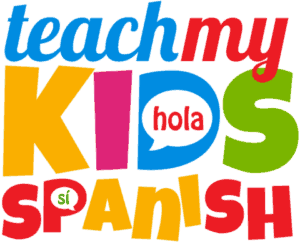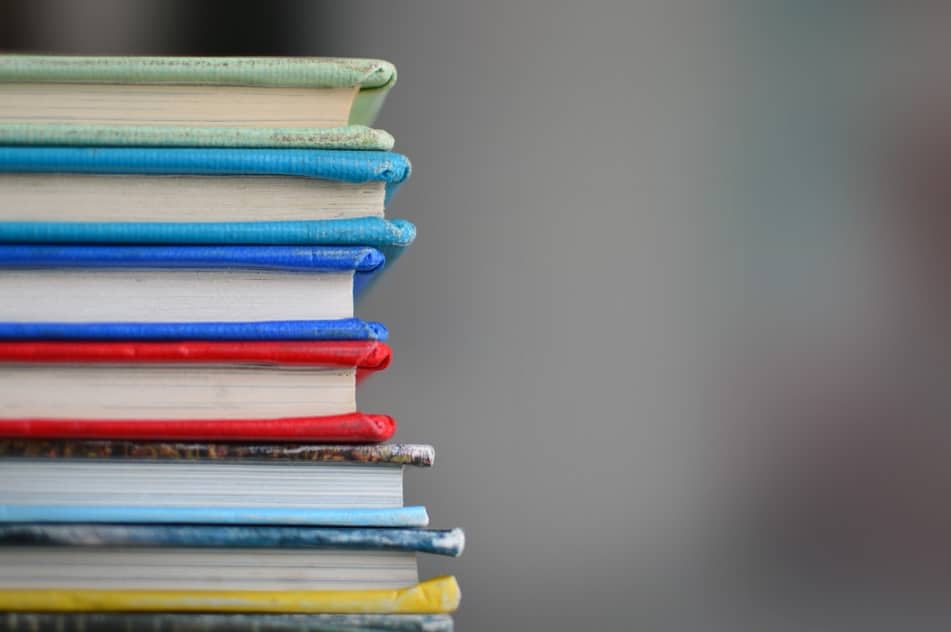
Learning another language, like Spanish, is a necessary skill in today’s world. The best time to learn a new language is as a child, while the synapses in the brain are still growing and forming. What better way to increase a child’s Spanish skills than by engaging them with books.
To find out what the 18 best Spanish books for kids are, keep reading. You’ll find a list of titles, a summary of the book, and why it’s a good read for kids who are learning Spanish.
The Best Books for Young Children or Beginning Spanish Speakers
Babies and toddlers have a better ear for discerning sounds, so this is the perfect age to start teaching them the Spanish language. Toddlers can pick up accents and apply them to words quite easily compared with teenagers and adults.
When choosing books to teach a young child (ages 1-7) Spanish, the features from the list above that you want to look for are:
- Vivid colors
- Shapes
- Numbers
- Visually appealing pictures
- Repetition of sounds
- Repetition of words
The colors, shapes and pictures will grab a young child’s attention immediately and keep them engaged enough to want to learn the words associated with the pictures.
Around 18 months of age is when children are usually ready to learn their colors, so teach the colors in both languages.
Between ages 2 to 4 years old, children are amenable to learning numbers, so, like their colors and shapes, a great way to teach this is in Spanish along with the child’s native language.
My First 100 Words- Mis Primeras 100 Palabras
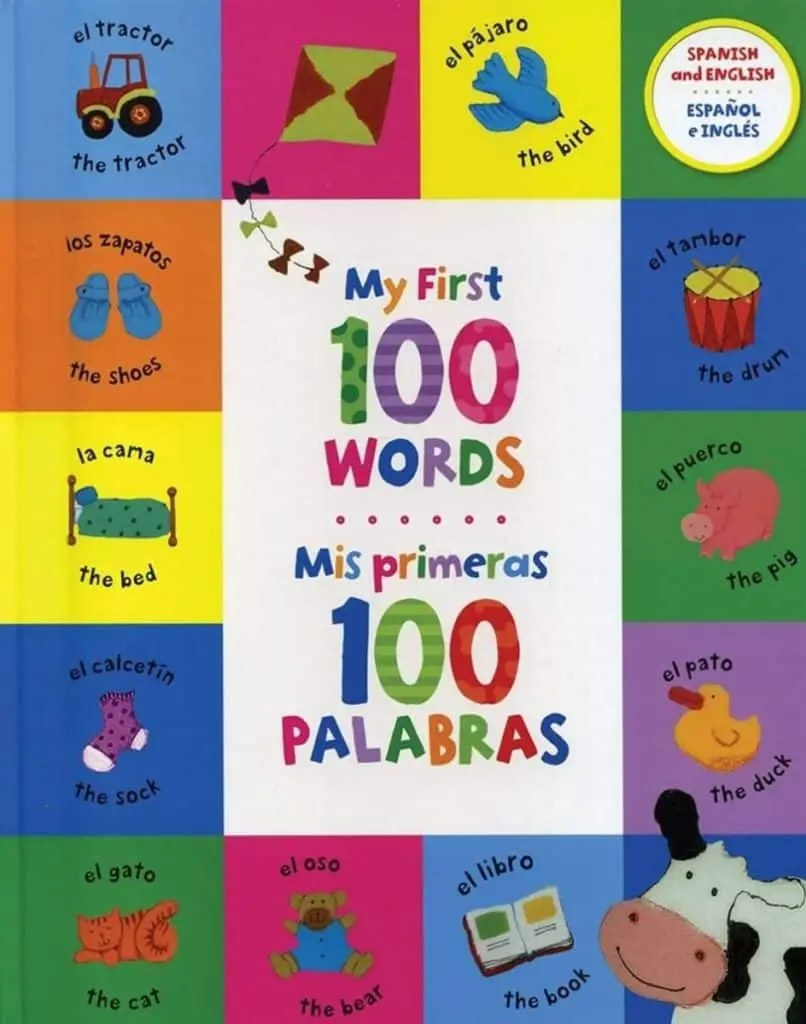
My First 100 Words- Mis Primeras 100 Palabras is a bilingual book for children ages 1-7. This book is effective in teaching children Spanish vocabulary and phrases because it incorporates:
- Bright colors
- Engaging pictures
- Contexts provided for different groups of words
Each page shows a different setting or theme in order to teach groups of words together. For example, there are two pages about the family unit. Along with the characters, are the different words for different relatives such as:
- Mother/Father
- Sister/Brother
- Grandmother/Grandfather
- Aunt/Uncle
- Niece/Nephew
- Daughter/Son
- Cousin
The pictures that are associated with the Spanish and English words help young children to apply those words to the people in their own lives and make sense of their meanings.
One way to help your young child acquire the Spanish language is to point to a picture and ask what the object is. If they don’t know, then say the word for them and have them point to the picture and repeat the word.
Pointing brings a kinesthetic aspect to creating an association between:
- The picture
- The word
- The sounds
- The meaning
Muu.Bee. Asi Fui! Is a Classic
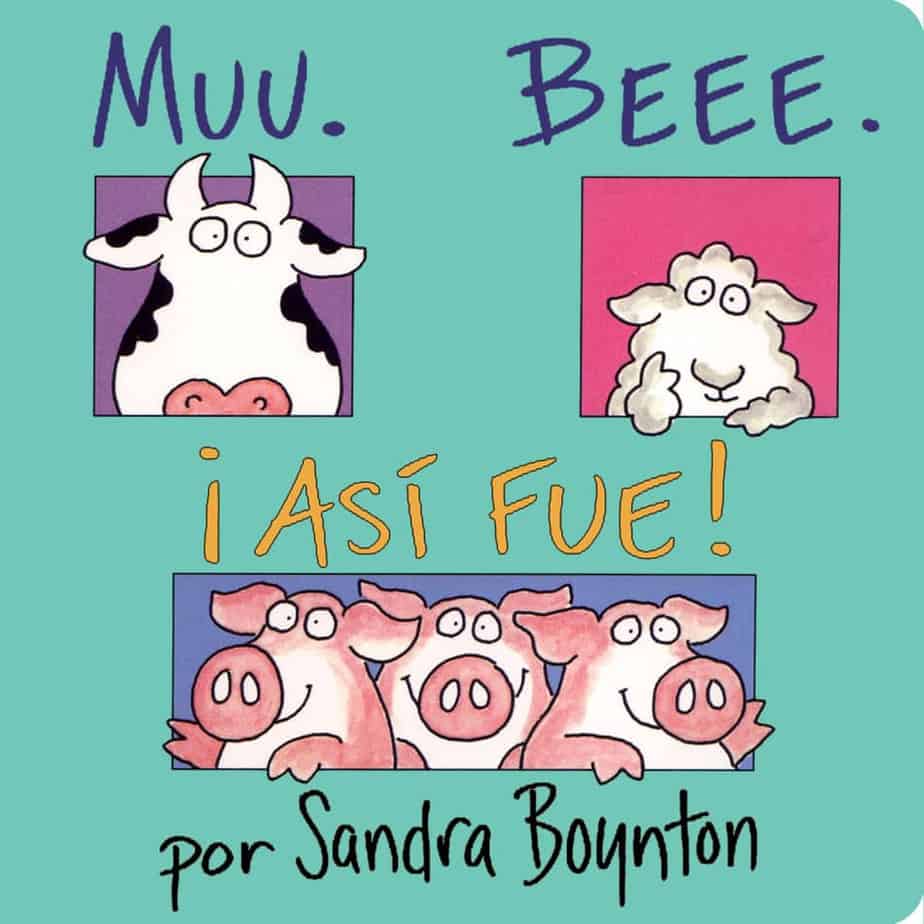
Muu. Bee. Asi Fui! By Sandra Boynton is a classic in any language. For teaching Spanish to toddlers and young children, this book is perfect because it teaches phonetic sounds that are the foundation of the Spanish alphabet.
Fans of Boynton’s children’s’ books will recognize the zany characters featured in Muu. Bee. Asi Fui! The recognition will help children to quickly connect to the book. Children will laugh and have fun while learning key Spanish sounds through sing song verses on every page.
The size of this board book also makes it easy for young children to be able to hold and turn the pages so they can read it independently if they want to.
Toddlers build their language skills by transitioning from babbling to a solid vocabulary. This silly story, with its animal sounds provides the foundation for that to happen.
For older children, just beginning their study of the Spanish language, this is a great book to illustrate how familiar sounds are perceived differently in Spanish. For example, in English, we say ‘the sheep says baa,’ but to the Spanish ear, it sounds like ‘bee.’
Besos for Baby: A Little Book of Kisses is About Family Love
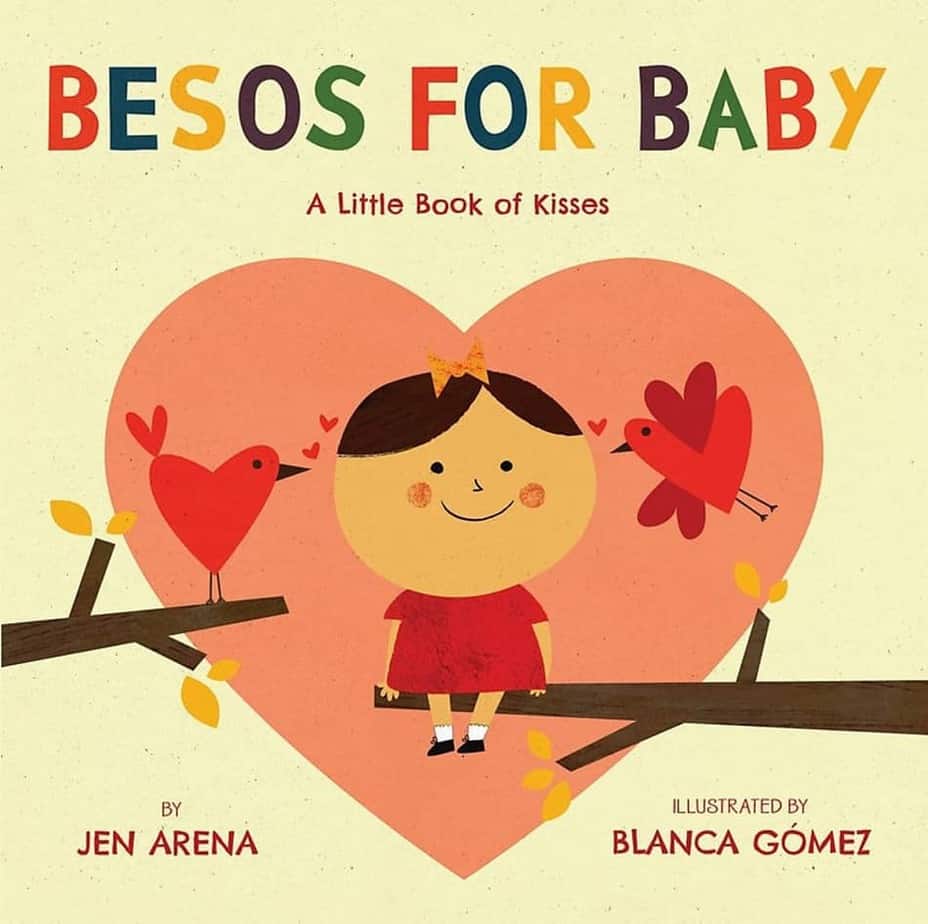
The perfect book for introducing your little one to the spanish language is Besos for Baby: A Little Book of Kisses. It is a story about the love between a parent and a child.
This adorable board book, authored by Jen Arena, is written in a bilingual format so your baby or toddler can learn the vocabulary of love in both English and Spanish.
In addition to learning Spanish, this book provides the language to bond with your child and the words associated with the emotions and feelings of love.
Elefantitos Introduces Counting
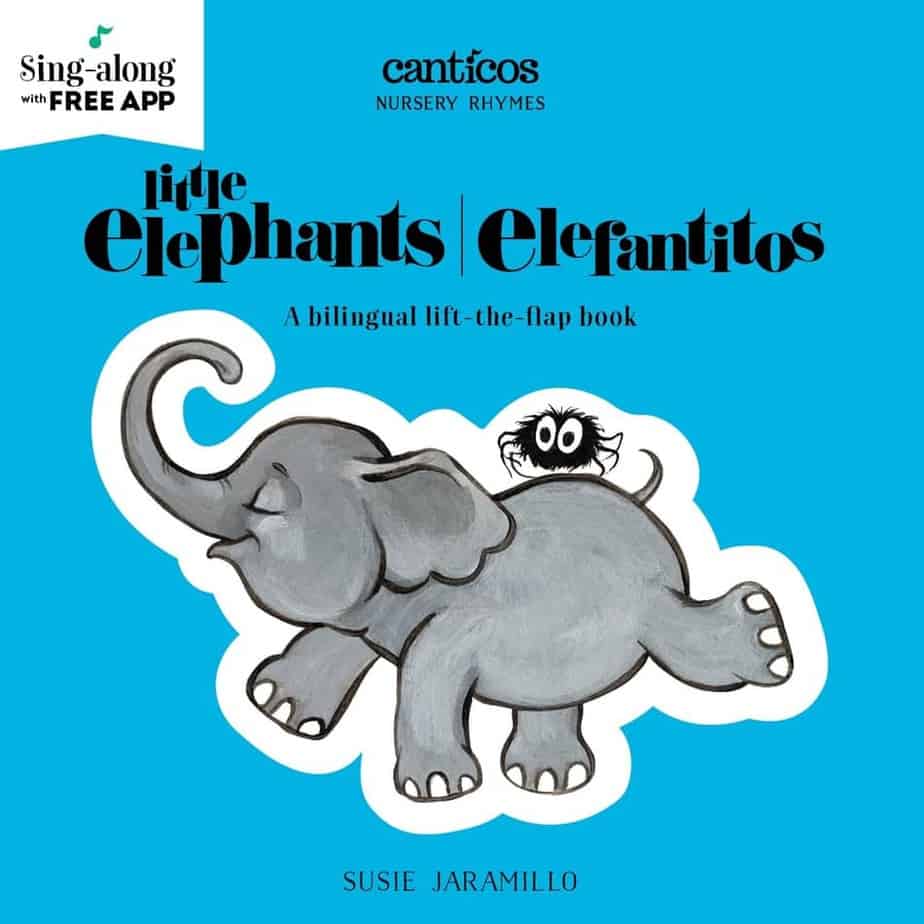
Based on the classic Mexican children’s song “Un elefante se balanceaba” Elefantitos is a fun board book that your child will want to read again and again.
The song has been used for decades to introduce numbers and counting in a fun and interactive way. It describes one elephant balancing himself on a spider web and then looking for friends to try it with him.
The elephants are successful until the tenth friend joins the group, and then they all fall down into the water below.
Elefantitos written by Susie Jaramillo is an accordion book that tells the story of the little elephants, including the following features to engage children:
- Bright colors
- Numbers
- Puppets
- Lift up flap features
The puppets and lift up flap features bring the story to life and engage bodily kinesthetic learners in making connections between the actions portrayed in the story and the words associated with those actions.
The book is written in both English and Spanish. Read it forward to read the story in its native Spanish language and then go backwards to read the English adaptation. Your child will have fun while learning to count and learning a cultural classic.
El Monstruo De Colores Teaches Emotions
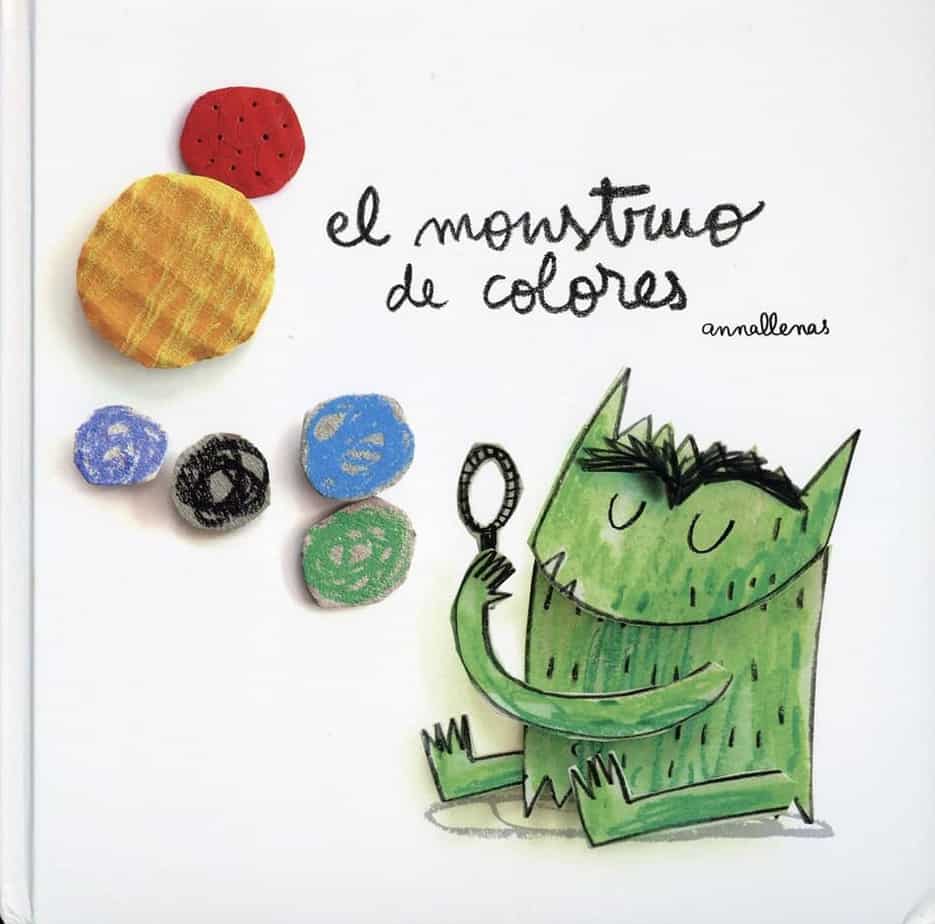
This sweet board book is a gem for visual learners. The story is about a little monster who wakes up one morning feeling confused. He flows through the spectrum of emotions:
- Angry
- Happy
- Sad
- Calm
- Scared
A little girl helps the monster to understand his feelings by assigning a color to each emotion. As the little monster learns to identify and sort out his emotions along the way, he gains:
- Self-awareness
- Peace
Written by Anna Llenas, El Monstruo de Colores is written in such a way that makes social, emotional awareness engaging. Children also gain an awareness of colors and how they can affect emotions as well.
The Best Books for Building Spanish Language Skills
Whether your child is just learning Spanish or needs to continue building upon the basics, this list of books are perfect for learning:
- New vocabulary
- Grammar
- Sentence Structure
- Building familiarity with the Spanish language
This selection of books will keep your child’s interest and motivate them to want to keep reading and challenging themselves as they encounter more complex Spanish language skills.
The Complete Book of Starter Spanish, Grades Preschool-1
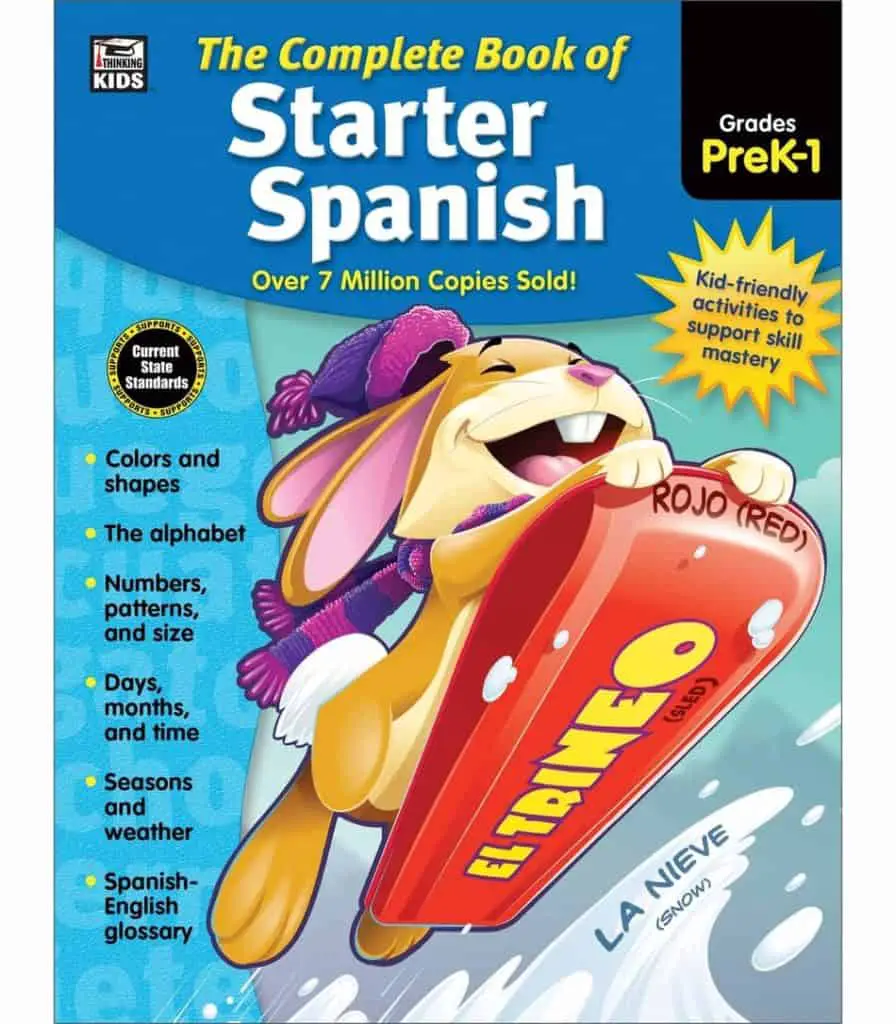
For explicit instruction, The Complete Book of Starter Spanish by Carson Dellosa is a great pick for any child from preschool through first grade.
This book includes the gamut of topics such as:
- The alphabet
- Numbers
- Colors
- Shapes
- Sight words
- Spanish songs and rhymes
This 416-page workbook provides instructions that are easy for young learners to follow to help them learn the topics above. The Spanish songs and rhymes provide insight into Spanish culture in addition to language skills.
Besides developing an understanding of culture and everyday life, students will gain the following skills:
- Speaking
- Singing
- Writing
- Reading basic words and phrases
This book can be used in the classroom or at home under parental guidance to enhance children’s’ acquisition of the Spanish language and fluency.
Juegos Tradicionales Teaches Cultural Games
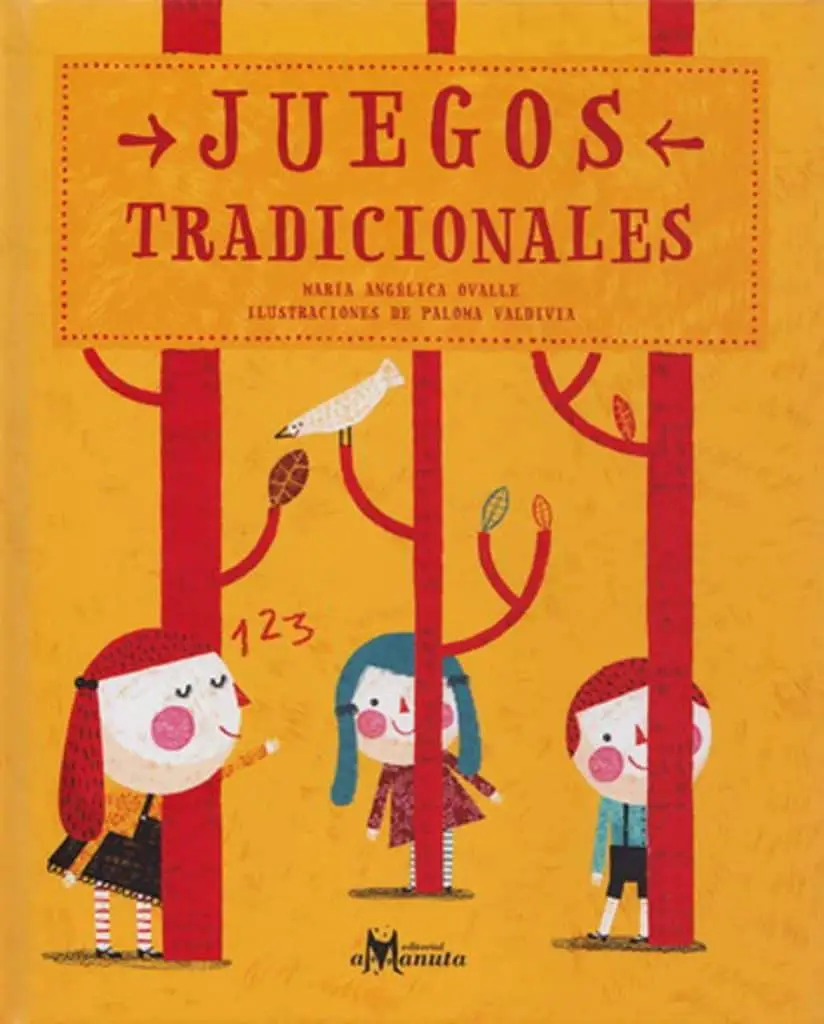
Maria Angelica Ovalle wrote Juegos Tradicionales to compile a collection of traditional games for children. Published in Chile, the book is written for children in Spanish and is a great learning tool for students of all ages.
The colors and drawings will keep visual learners interested in learning about the cultural games. Teachers can use this book in the classroom to have students practice their conversation skills in Spanish by explaining the rules of the game to other children.
After explaining the games, children can play the games. These games would make great activities for going outside to learn on a nice day. Bodily kinesthetic learners will create language meaning from being active and performing commands.
Learning the rules of the game and then explaining them (or listening to the explanation) are great ways for students to learn the difference in making commands in Spanish versus using the same verbs in a non-command form.
Matilda an English Classic
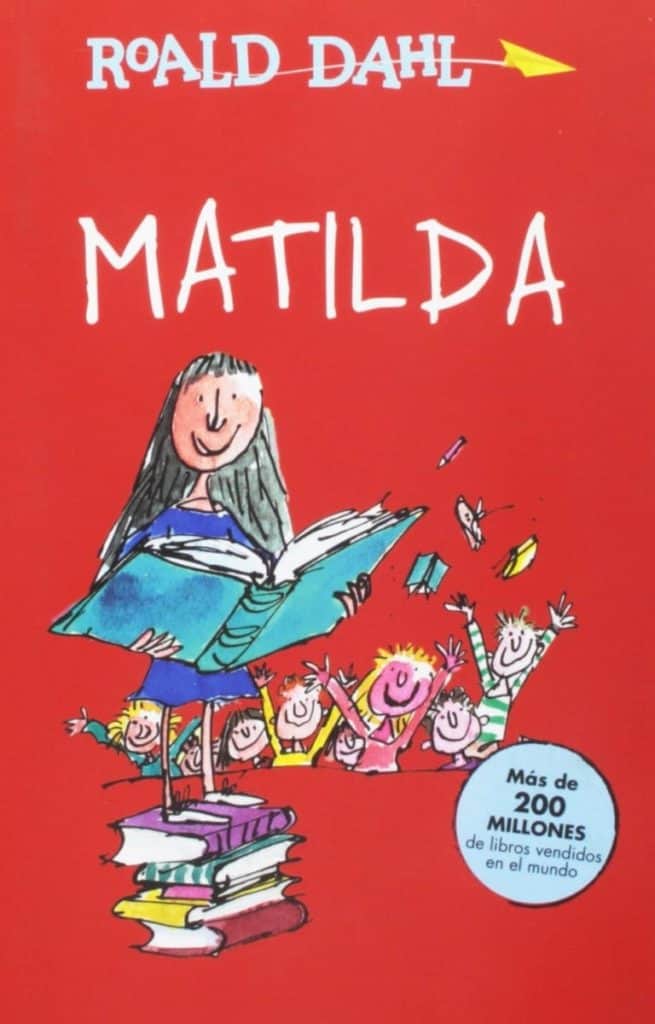
The Spanish version of the Roald Dahl classic Matilda is the perfect story to read in Spanish. Many children already know the story from the English book or movie and therefore have a context to build from.
The familiarity allows readers to easily figure out new vocabulary and adapt to sentence structure and grammar with ease.
The fun storyline is engaging and will keep readers wanting more. The challenge of reading a chapter book in another language is another motivational factor.
La cenicienta the Perfect Cinderella Story
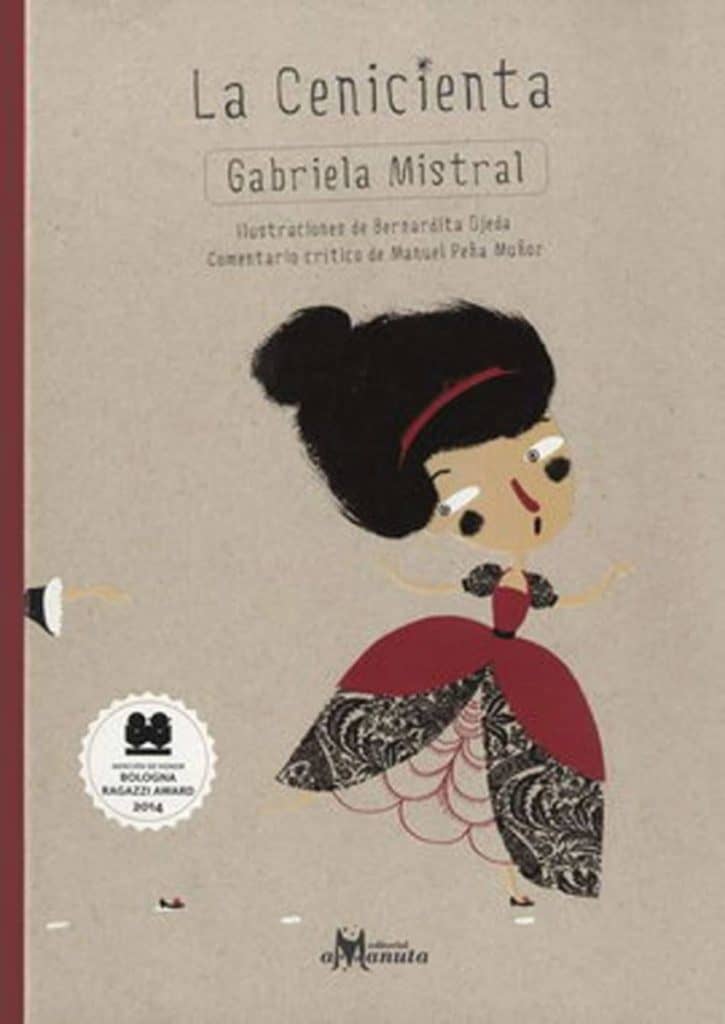
This Chilean version of the Cinderella story by Gabriela Mistral is developmentally appropriate for ages 6 through 12. No matter your age, this story will capture the attention and spirit of the reader while promoting Spanish language fluency.
Written by Nobel Prize winning Chilean author Gabriela Mistral, this book is a break away from her usual poetry, though the prose reflects Mistral’s poetic influence.
Younger children will be entranced with the beauty of the story. Older children will gain a greater understanding of Spanish culture and literature from the gentle rhythms of the poetic language.
The Best Authentic Spanish Books for Children
How better to immerse young Spanish learners in both the language and culture than to include authentic Spanish language books in their library?
These books are authored by native Spanish speakers who are residents of Spanish-speaking countries and are staples in the native Spanish speaking child’s library.
Filled with culture and unique stories, they will grab the attention of younger Spanish language learners.
The authentic voices of these Spanish speaking authors show through in the personalities of their characters and the heritages and culture they share with the reader.
De Colores and Other Latin American Folksongs for Children
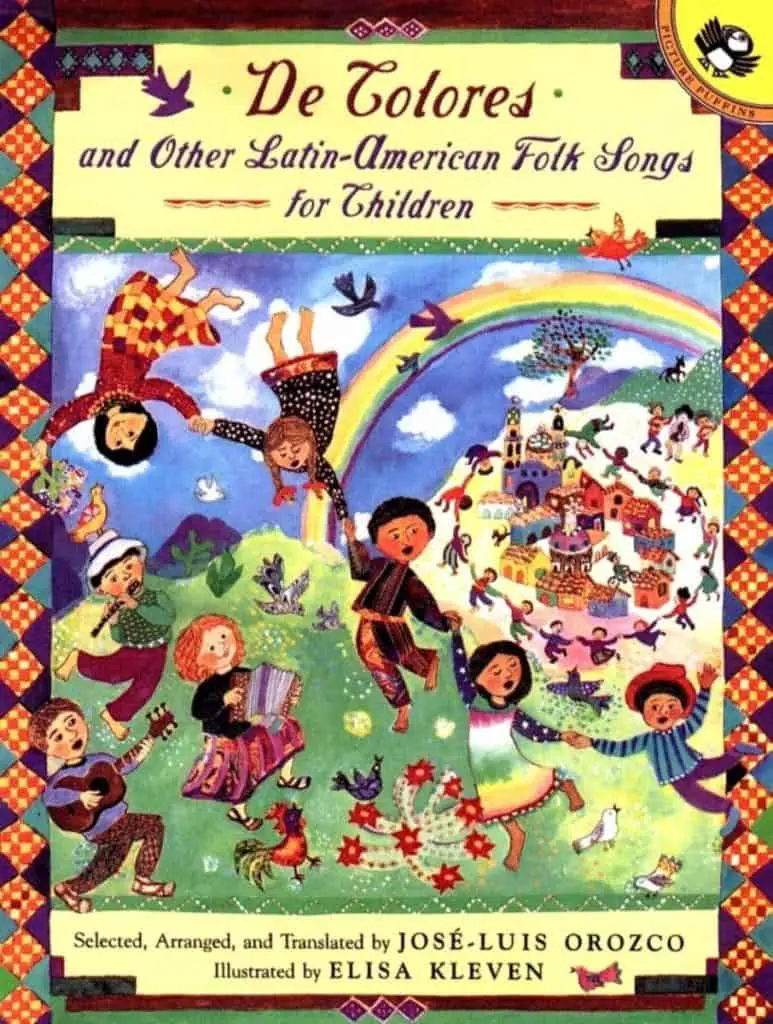
Stories and songs are the heart of any culture. Originally authored published in 1999, De Colores and Other Latin American Folksongs for Children by Jose-Luis Orozco and illustrated by Elisa Kleven is a collection of:
- Traditional tunes
- Rhymes
- Hand games
Lyrics are included in both Spanish and English. There are songs for all occasions and moods accompanied by simple musical arrangements that make it easy for children to learn.
This book is often used in classrooms to teach:
- Music
- Multicultural studies
It can also be used at home as a fun way to introduce children to the Spanish language and Hispanic culture.
Juan Bobo Busca Trabajo Hilarious Folklore
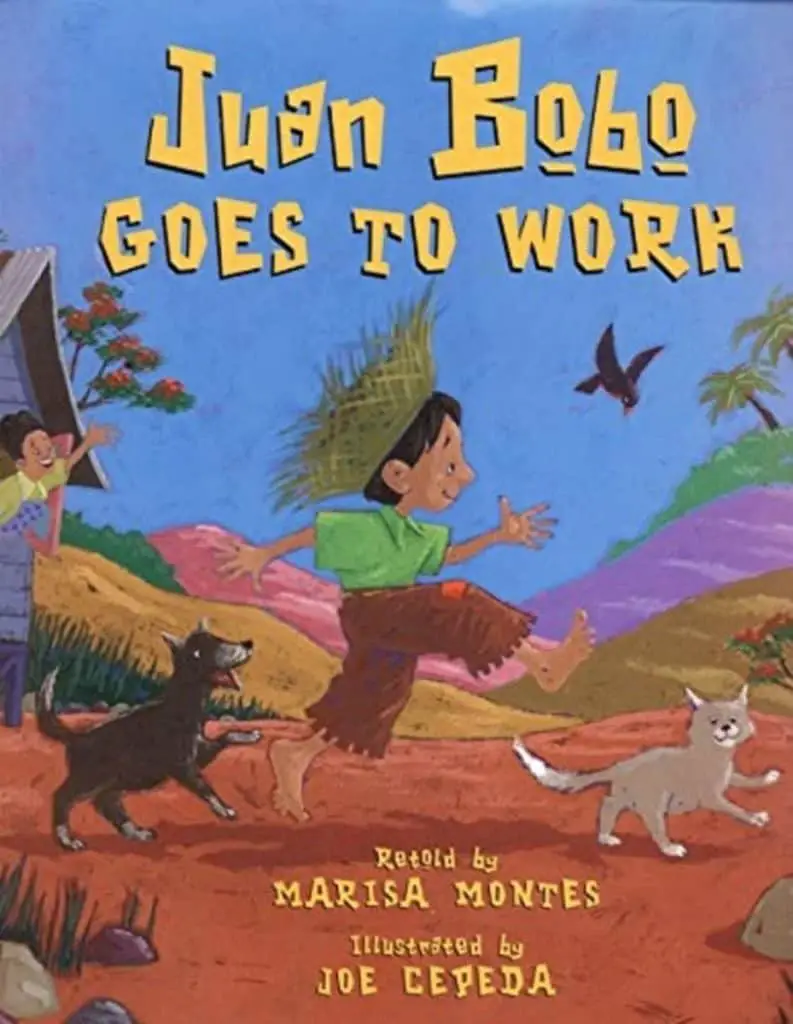
This touching story is a piece of Puerto Rican folklore written by Marisa Montes about a little boy who is called Juan Bobo or “Simple John” by the people who know him.
Readers will laugh at the hilarious debacles that Juan Bobo commits as he sets out to look for work.
Juan Bobo tries to work at both a farm and a grocery store but continues to blunder even the simplest of tasks. The beautiful illustrations by Joe Cepeda enhance the comedy of the story.
Through one of Puerto Rico’s most celebrated literary characters, children will soak in the Spanish language along with life the lessons about never giving up and always trying to do your best.
Xochitl and the Flowers/ Xochitl la nina de las flores Great for 6-9 Year Olds
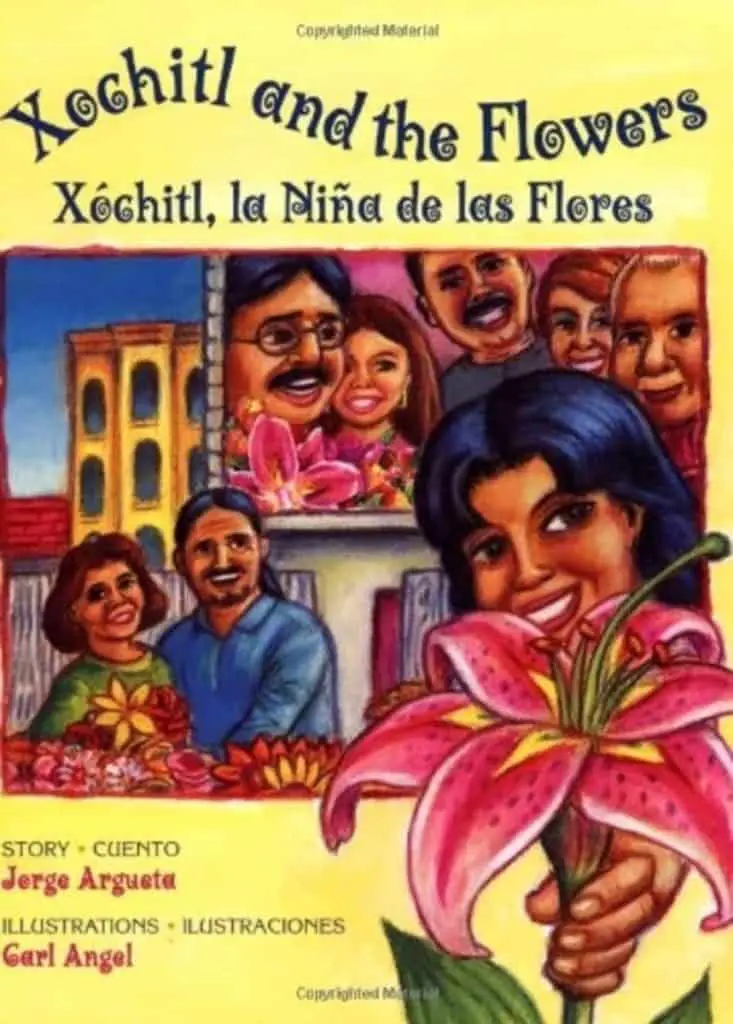
Written by Jorge Argueta, this book is great for Spanish learners ages 6 to 9 years old. It is formatted to be bilingual. One page is written in English; the next is the same page in Spanish. This lets children put new vocabulary words into a meaningful context.
Xochitl and her family have just relocated to the United States, but she misses home in El Salvador, especially her garden and the family flower shop. The family decides to start a new nursery and sell their flowers on the street.
In starting this new business, the family starts to build connections and friendships with their new neighbors. Together they create a sense of community with those around them.
The decision to start their business over again allows Xochitl’s family to feel at home in their new country. This is a great book to teach about:
- Overcoming adversity
- Friendship
- The importance of community
El sombrero del tio Nacho/ Uncle Nacho’s Hat is a Nicaraguan Folk Tale
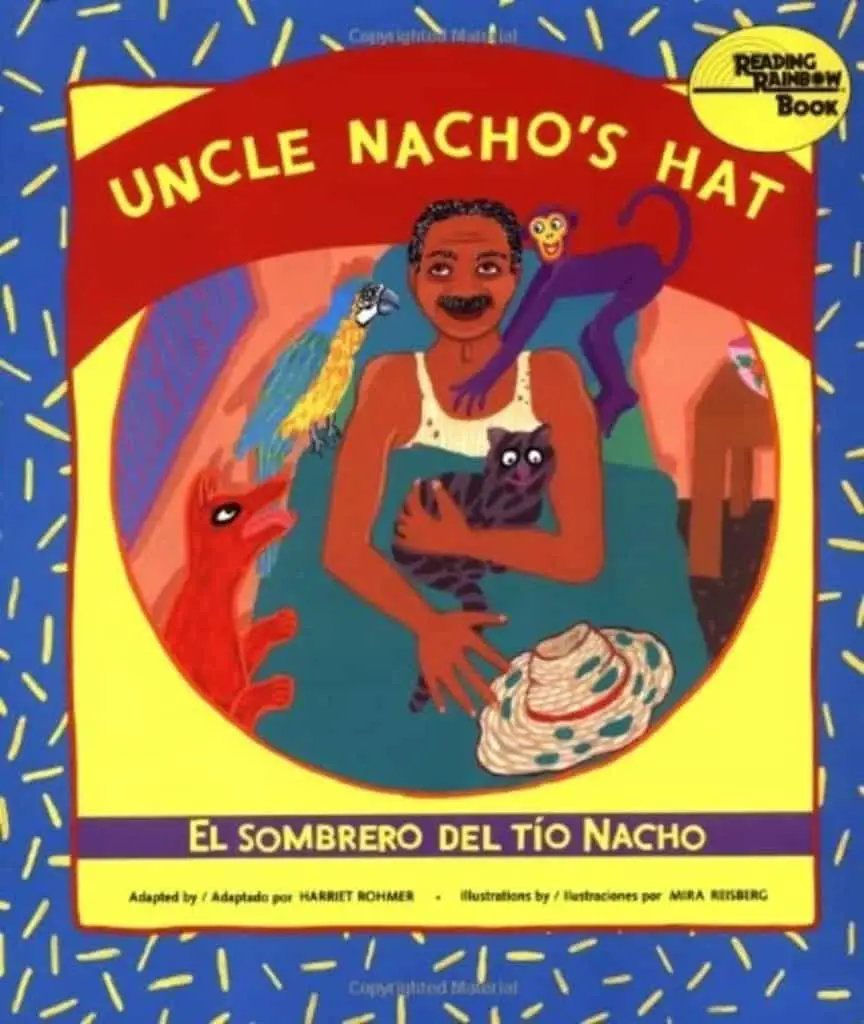
This book is written both in Spanish and English by Harriet Rohmer and artfully illustrated by Mira Reisberg.
The story is about young Ambrosia, who gives her Uncle Nacho a new hat. When he tries to get rid of the old one, it keeps coming back to him.
This classic Nicaraguan folk tale from the Puppet Workshop of Nicaragua is a parable about how hard it can be to make changes, get rid of old habits, and let new things into our lives. These lessons are important for learners of all ages.
This riveting story includes an account of the origins of the story, adding a cultural piece to the language skills.
La Isla is Full of Adventures
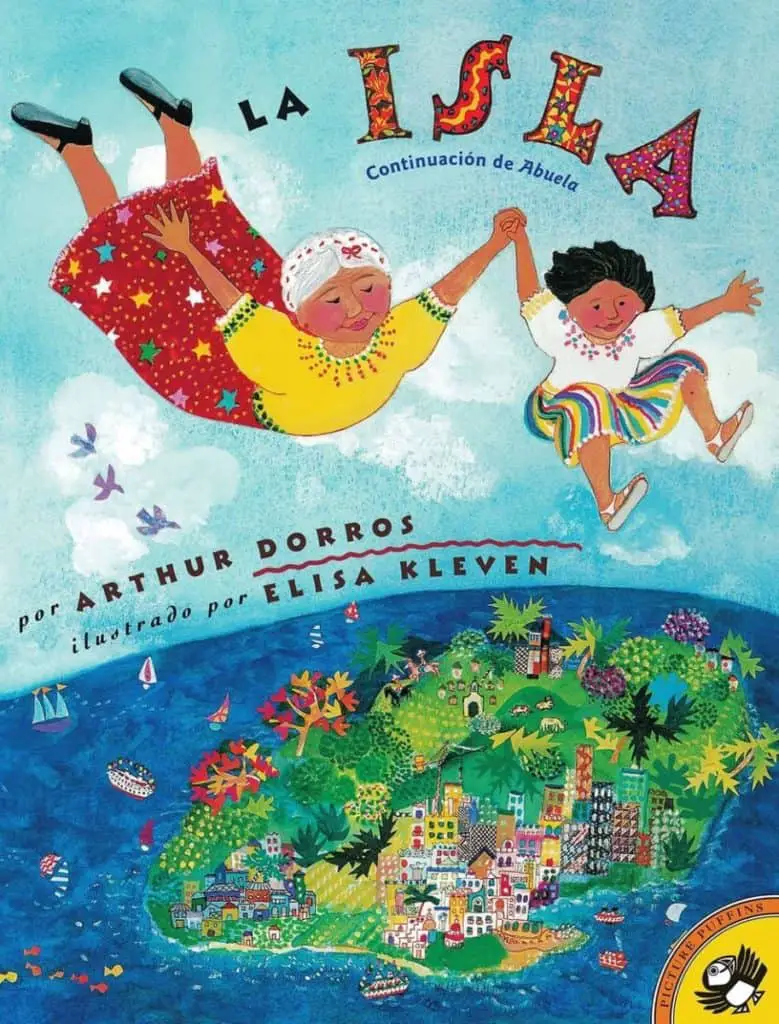
La Isla is the story of Rosalba and her grandmother and the adventures they go on whenever they are together. This is the follow up book to Arthur Dorros’ Abuela, the story of Rosalba and her grandmother exploring New York City through both imagination and spirit.
In this follow up book, Rosalba and her grandmother travel to La Isla, where her grandmother grew up. Through her vivid imagination, Rosalba experiences her grandmother’s stories growing up on La Isla and the pride she has for her homeland.
The collage-like illustrations by Elisa Kleven powerfully illustrate the trips that Rosalba and her grandmother take in their minds. La Isla is storytelling at its absolute best.
The Best Spanish Books for Older Children
It’s important for older children to continue reading and developing their Spanish speaking skills or have the opportunity to read well-written stories in their native language.
The following selection of books will stretch the Spanish skills of children ages 7 to 11 through books that teach:
- Life lessons
- Heritage
- About real people
The longer books and developmentally appropriate reading levels will increase the complexity of vocabulary and sentence structure in order to stretch students’ language acquisition skills.
Salsa Stories Focuses on Culinary Traditions
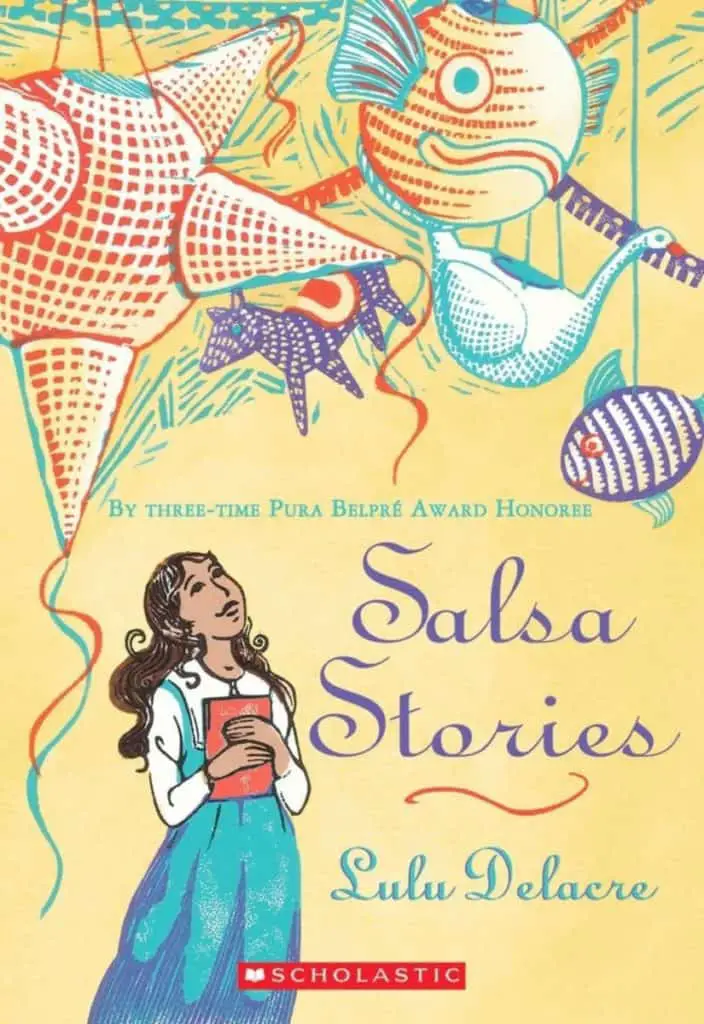
A classic chapter book for children ages 7-10, Salsa Stories by Lulu Delacre focuses on cultural tradition.
The premise of the story is that young Carmen Teresa receives a special notebook as a gift. Friends and family suggest she write down their own childhood stories.
But Carmen Teresa has other ideas. She loves to cook, so she decides to collect special family recipes instead.
Each vignette details a specific family tradition through the lens of the food that is lovingly prepared for family and friends as they observe cultural events and holidays throughout the year.
Delacre, a native of Puerto Rico, started writing because there were so few authentic books in Spanish in the United States for her to read to her own children, so she decided to fix that problem by writing her own.
This book has editions written in both Spanish and English. The English edition infuses Spanish vocabulary throughout each vignette and includes traditional Puerto Rican recipes that are eaten at various cultural celebrations.
A glossary is included at the end of the book and includes a pronunciation key and definition for the Spanish words sprinkled throughout her stories.
Pasando Paginas: La historia de mi vida is a Journey to the Supreme Court
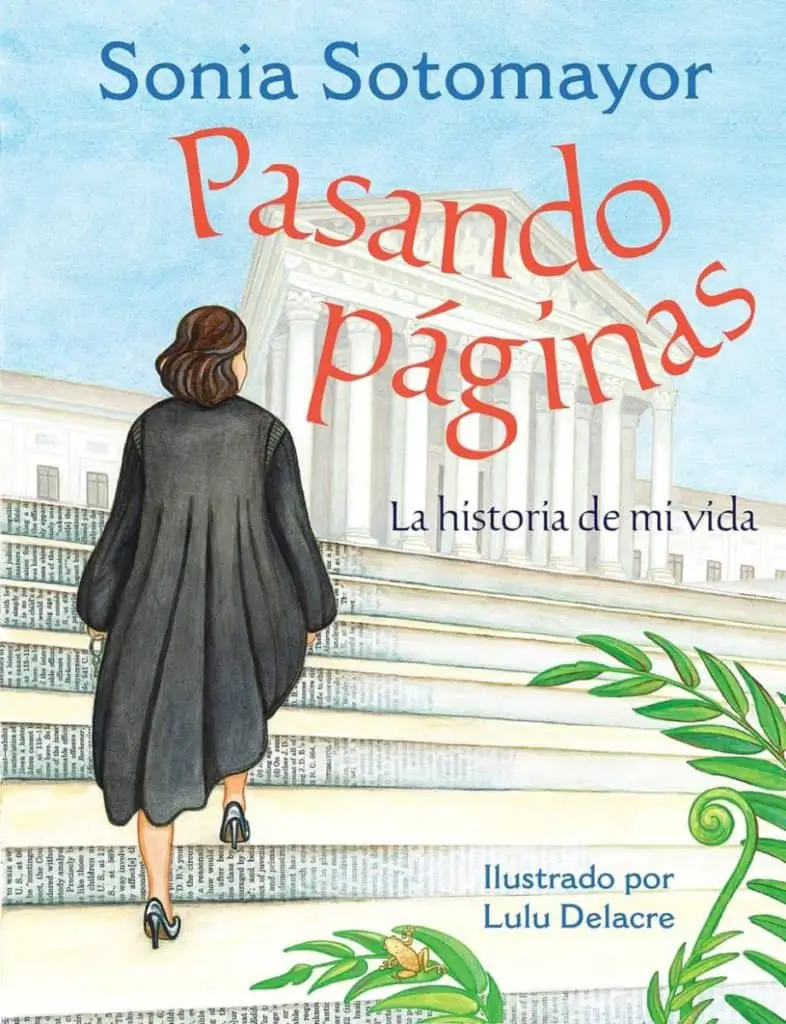
Older children will enjoy learning about Sonia Sotomayor’s journey to the Supreme court as they read Pasando Paginas. Sotomayor, the first Latina woman to serve as a judge on the U.S. Supreme Court, is an inspiration to people all over the world.
In this autobiography, beautifully illustrated by Puerto Rican writer and artist Lulu Delacre, Sotomayor describes how her love for books provided the inspiration she needed to reach her dreams. Books were her:
- Mirror
- Maps
- Friends
- Teachers
Sotomayor describes how books helped her to connect with both her family in New York and in Puerto Rico. They helped her to deal with major life events such as:
- Her diagnosis of diabetes
- The death of her father
- Discovering the secrets of the world
Ms. Sotomayor encourages the next generation of readers to read and learn, so they too will have the knowledge and power to fulfill their dreams. This book sends the message that the world is full of possibilities, and it starts with the turn of a page.
Waiting for the Biblioburro/Esperando el Biblioburro Shows Impact of Learning
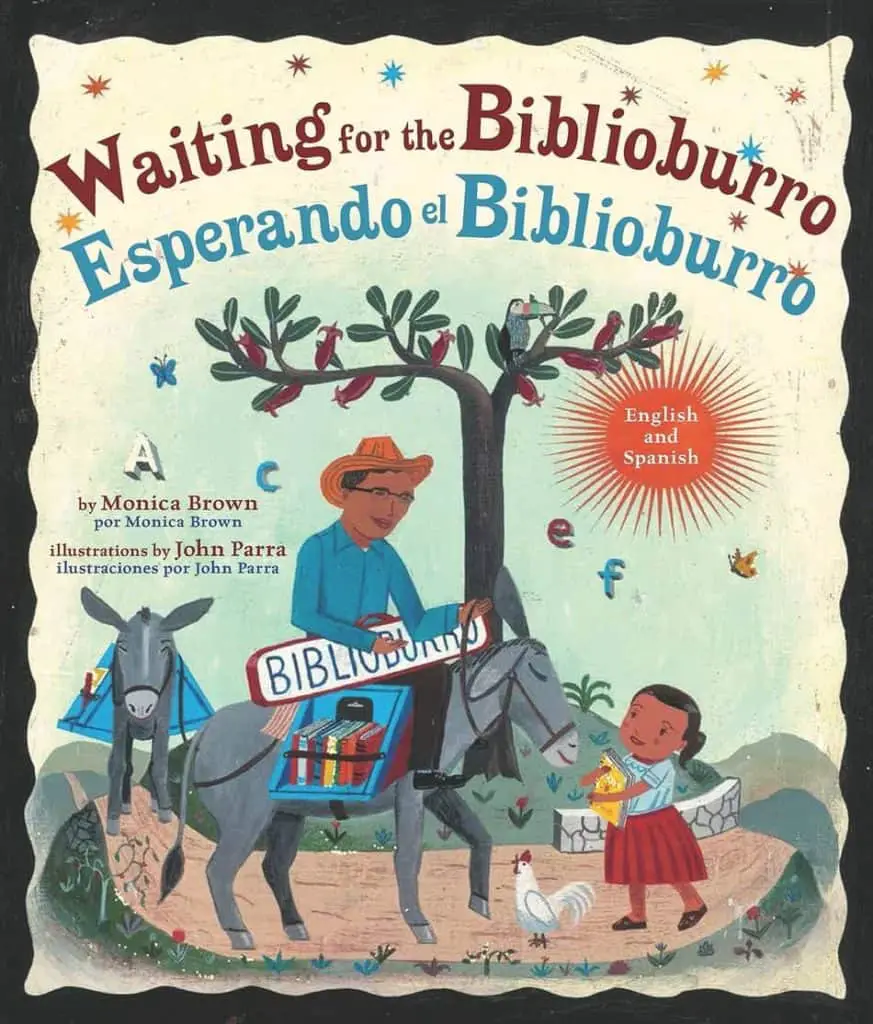
This bilingual book is written by Monica Brown and translated by Adriana Dominguez. Illustrations by John Parra bring the story to life. With English on one-page side by side with the Spanish translation on the other, children can easily figure out the meaning of new vocabulary words.
Waiting for the Biblioburro is the true story about Luis Soriano Bohorquez, the librarian. He packed up books, loaded up his burros, Alfa and Beto, and traveled across mountains and valleys to bring books to children all across rural Colombia.
This special book tells about the impact that Soriano Bohorquez had on children by providing them with the chance to learn about literature and culture.
Brown’s Peruvian American heritage has inspired her to write stories for children about Latino culture.
Dancing Home/Nacer Bailando a Story About Identity
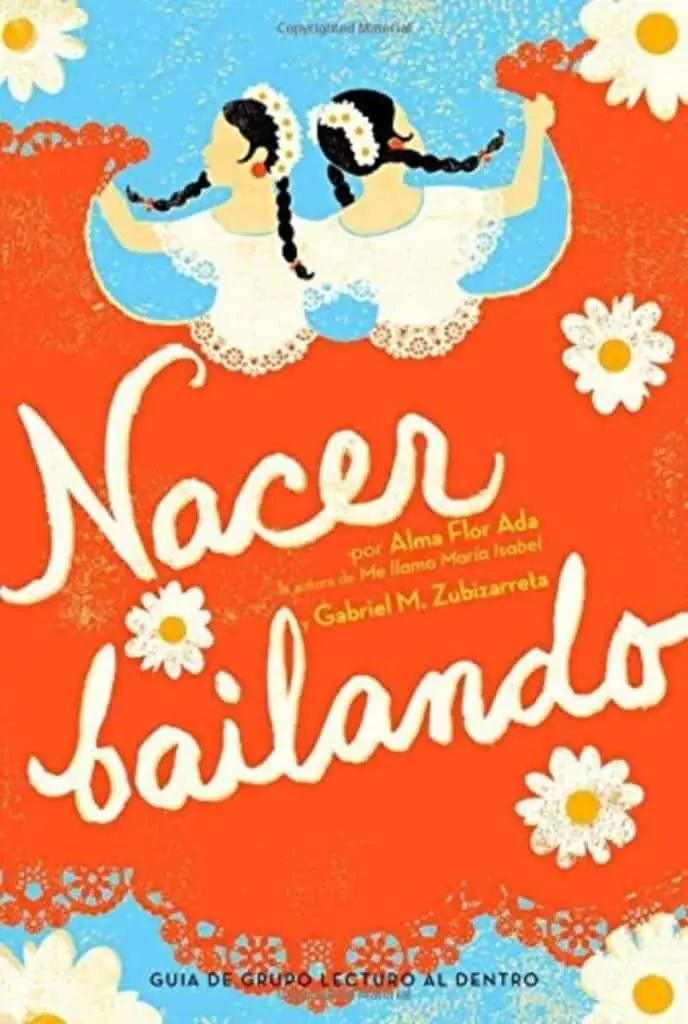
This story is a collaboration written by Alma Flor Ada, an award winning Cuban American author, and Gabriel Zubizarreta. It is written for children in grades 3 through 6.
There are two editions of the book, one in English and one in Spanish. Nacer Bailando tells the story of two cousins Margarita and Lupe in alternating chapters.
Margarita (Margie) was born in the United States. Born in Mexico, Lupe comes to stay with Margie’s family in California. Margie is disappointed when Lupe, who doesn’t speak English, is enrolled in Margie’s class, and Margie is expected to translate for her.
Both girls feel alienated by their heritage when classroom bullies belittle them. Lupe is later moved to a bilingual class where she meets Camille, who has a passion for learning and life.
Through Camille’s influence, Lupe takes folkloric dance and gives a performance that helps Margie understand how both her American and Mexican heritage are part of her identity.
In addition to building Spanish language skills, readers will develop an appreciation for their own heritage and that of others.
Selecting the Best Books for Your Kids Learning Spanish
The best way to learn a new language is to learn it through multiple learning modalities. Young children tend to love to explore the world through books. A lot of their first impressions about the world come from features in books.
Stories and pictures capture the attention of children and keep them engaged. These books typically include some of the following features:
- Vivid colors
- Big pictures
- Shapes
- Numbers
- Repetition of sounds
- Repetition of words
- Interesting characters
- Stories that teach a lesson
- Stories that teach a new concept in a fun way
The best books for teaching Spanish include all of the features above. The features that engage Spanish language learners may change as they grow older but when looking for the best books to teach children Spanish, keep the above list in mind.
Aside from choosing books that include the features above, when reading Spanish books to young learners, parents and teachers can do the following things to emphasize language skills.
- Point and ask the child (if they are old enough) to say the word
- Use gestures along with the words- for example if you are talking about eating, tap your lips
- Talk about what is happening in the story. Ask questions to check for understanding and share meaning
- Chat back and forth about the story
- Model bigger and better sentences as a child’s language skills increase
- Have students trace the letters or words as they practice making the associated sounds
- Find the words in the books on other objects (label foods, furniture, toys, dishes and other household items with the name in spanish) to practice reading and saying the words in a real-world context.
Reading to Promote Fluency in Young Spanish Readers
This selection of books is designed to promote language acquisition and fluency of the Spanish language in children over a range of ages.
The books on this list are designed to be developmentally appropriate but can be read across ages depending on the skill level of the reader.
For example, it is not a bad idea for older children who are first being exposed to the Spanish language to read books written for infants and toddlers. By doing so, they will build vocabulary and learn the foundational sounds of the Spanish alphabet.
Conversely, it doesn’t hurt to expose your young children to picture books and chapter books to familiarize them with the language and cultural norms at a young age.
